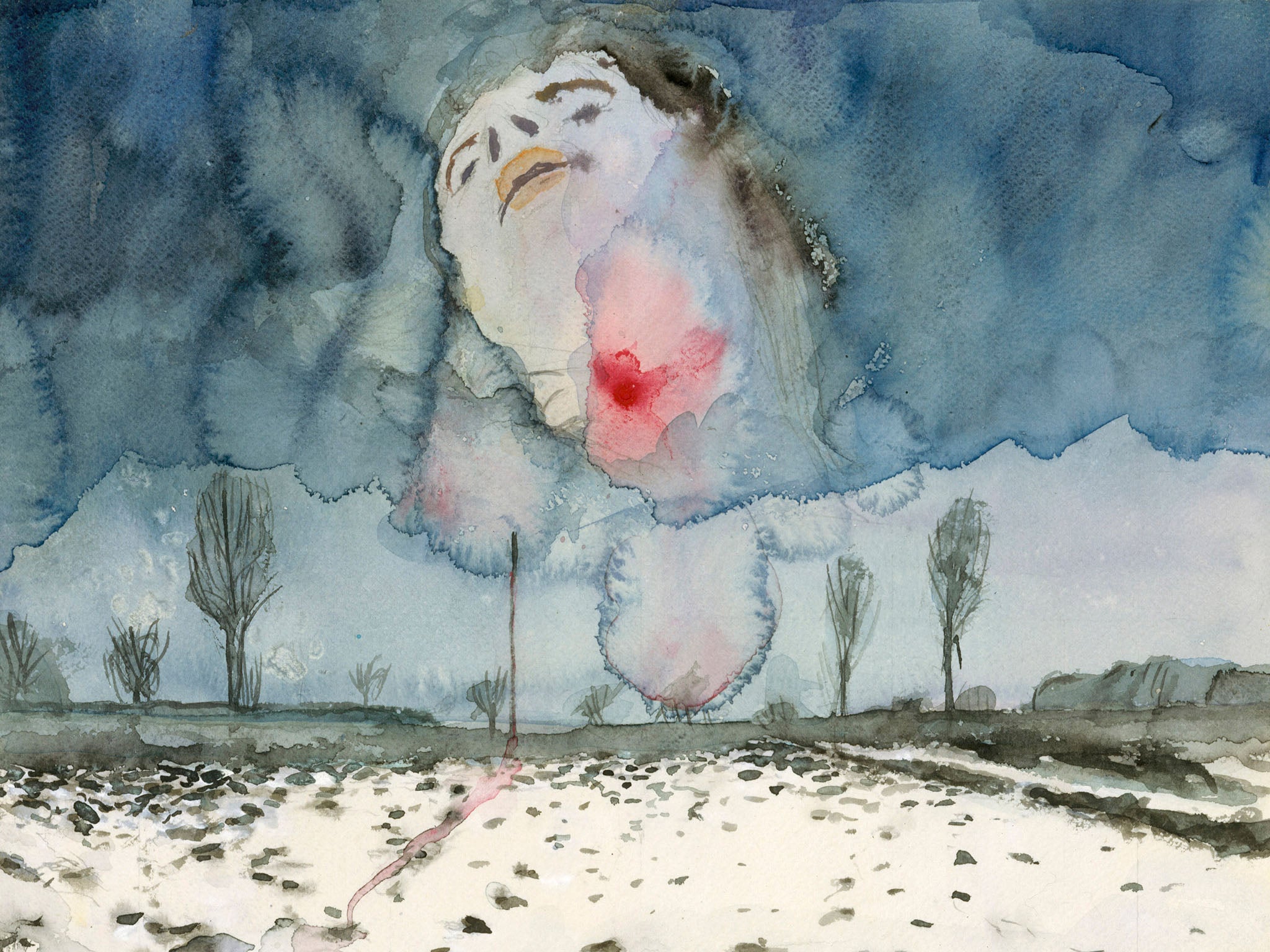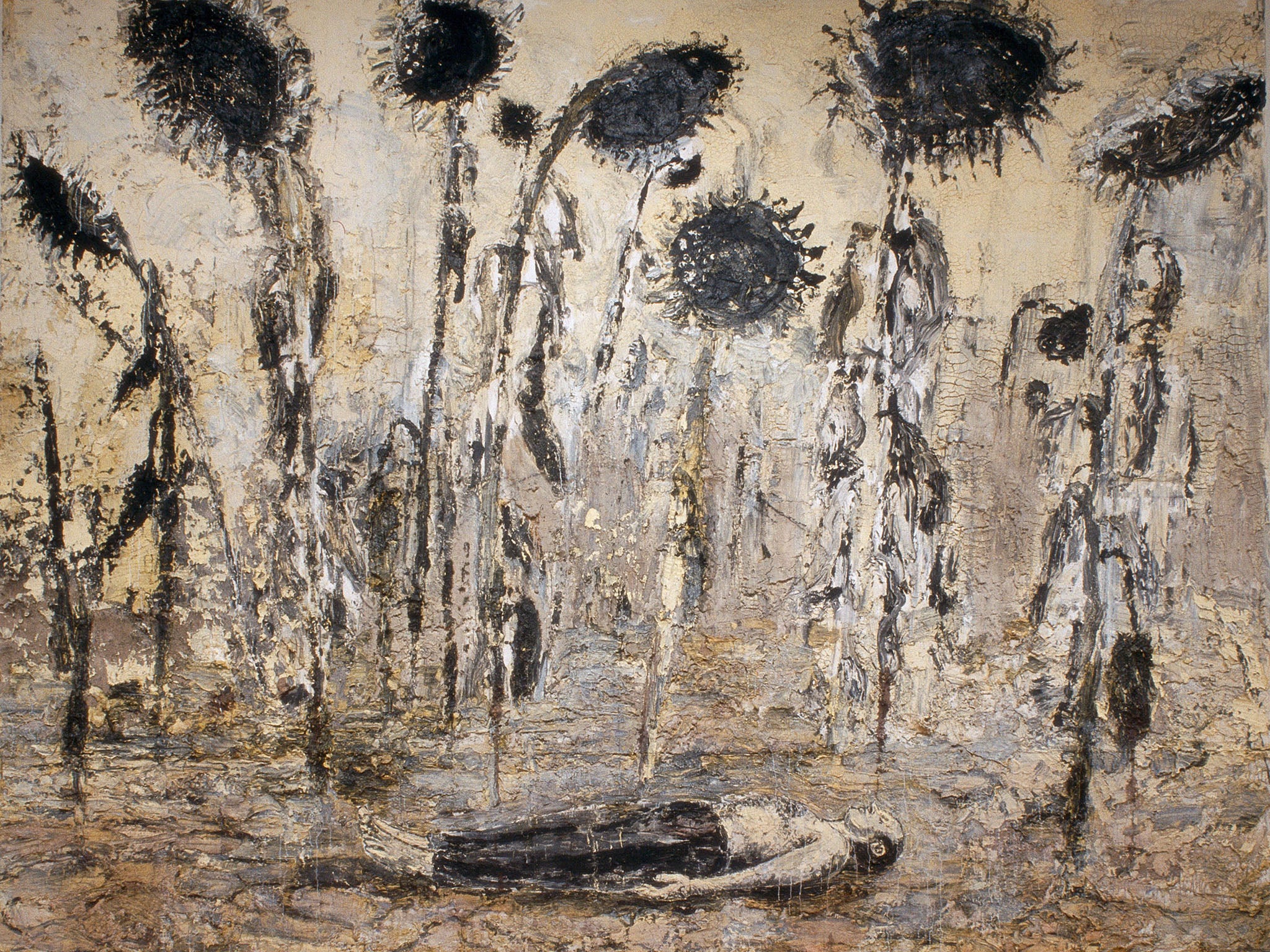Anselm Kiefer, Royal Academy, preview: Is he our greatest living artist?
Kiefer’s range seems limitless: the courtyard entrance to the Royal Academy will be dominated by his first ever vitrines for outdoor display, one containing ships, as it were, beached, the other with vessels afloat

The sunflowers are over for another year: the confident golden heads have drooped, their sunny countenances giving way to a black scowl.
It feels like a metaphor for the end of summer. But for the artist Anselm Kiefer, this is when sunflowers get interesting. Like his hero Van Gogh, he revisits the sunflower time and again, not for its buttery radiance, but for its blackened seeds. Sunflowers, in Kiefer’s work, are embedded into paintings, apparently dead, but bearing the potential for life.
The polarities of life and death, the heavens and the earth, micro and macro, are central to the work of the 69-year-old German painter and sculptor, described by the curator of a major retrospective of his work at the Royal Academy in London, opening this month, as “our greatest living artist”. Kathleen Soriano has worked closely with Kiefer, an honorary Academician elected by his peers, and while she has been selecting work from a career lasting almost 50 years, he has been making new pieces – 40 per cent of the work will not have been seen before, and much of it has been created with the architecture of the RA’s home in Burlington House in mind.
“One of the things that Anselm wanted to do was to respect the architecture,” explains Soriano. This is not simply an aesthetic response to a well-proportioned building, but a physical interaction with the bricks and mortar that can be both mankind’s triumph and its disgrace.
Kiefer, a child of the Second World War, was born into another polarity: on the one hand the grandiose, fascist buildings of architects such as Albert Speer, on the other, the rubble of bombed houses. On the day Kiefer was born, the neighbouring shop/house was destroyed, only a sewing machine propelled unbroken into the street, its isolation and solidity later echoing in works such as Black Flakes (2006), at first glance a desolate winter landscape, in which a book made of lead is embedded in the thawing snow.
Growing up with the heavy burden of his country’s wartime atrocities, Kiefer scandalised some when, early in his career, he produced images that were not only unacceptable but actually outlawed in Germany – depicting him, in a Nazi uniform, giving the Nazi salute. Due to feature in the first room of the exhibition, they force us to confront the past and raise the question of the role of the artist in the wake of a vicious regime. Though at the same time, Soriano says, “the work is as much about the present and the future … and the way he plumbs the past is always forewarning us about the evils of mankind.”
Kiefer wants to restore some of his country’s corrupted legacy, too. “The Nazis had tarnished so much mythology, and he wanted to reclaim it,” says Soriano. Much of that mythology lies in the woods and forests of Germany, which not only inspire the subjects of Kiefer’s work, but provide the materials. Going far beyond traditional oils and sculptural metals, Kiefer’s media for one work, based on the story of Isis reassembling her dismembered lover Osiris, reads: “Lead, concrete, roses, bramble, acrylic, emulsion, ash shellac …” Nothing is invalid as a material.

But even with the whole world as his supplier, Kiefer does not rest there. Another of the polarities that fascinates him is order and chaos. A completed work may, to him, appear too organised, and so he relinquishes it to nature – leaving it outdoors, allowing it to disintegrate. Curators and conservators have been known to retrieve flakes of paintings from the gallery floor, returning them to the artist, who incorporates them in other work. Sometimes he sets fire to his pieces; he has also shot at them. The ambiguity of fire intrigues him: it is cleansing and cauterising, but also disfiguring and destructive.
In contrast to the natural cathedrals of the forest canopy, Kiefer also paints vast, cavernous halls, but again he is drawn to extremes: on the one hand he admires their grand architecture; on the other, he is drawn to their simple building blocks. “He loves the idea of man making bricks as God makes stars,” says Soriano.
Kiefer’s range seems limitless: the courtyard entrance to the Royal Academy will be dominated by his first ever vitrines for outdoor display, one containing ships, as it were, beached, the other with vessels afloat. He is intrigued by the Russian Futurist Velimir Khlebnikov’s theory that history throws up a critical naval battle every 317 years. Even water, plain and simple, is ambiguous. When the Rhine, which forms a geographical border between Germany and France, flooded the basement of his childhood home, Kiefer wondered where the boundary lay then – in the midst of the swollen waters or in his cellar?
Landscape is important to him, and not only the golden lakes of sunflowers. The American Morgenthau Plan, devised in 1944 to strip a near-defeated Germany of its industry and turn it into a farm for Europe, is thought to have only strengthened the Nazis’ resolve, and cost more lives. Kiefer harvests the landscape in his own way, embedding straw in his portrayals of Margarete, a blond Aryan who appears in a series of paintings inspired by Paul Celan’s elegy to victims of the Holocaust, Death Fugue, alongside another figure from the poem, black-haired Jewish woman Shulamite.
Since 1968 Kiefer has been making books, the pages of which do not necessarily reveal obvious text and images: 48 will be on show at the RA, and the exhibition will conclude with a walk through the panels of a larger-than-life, concertina-like volume, called a leporello (after Don Giovanni’s servant, whose list of his master’s lovers that is so long he must fold it).
“People think of Kiefer’s work being so masculine and confrontational,” says Soriano, “and I don’t think they understand his gentle side. What I want people to take away from this show is not only the knowledge that he is a great painter, but also that he has great relevance.” Indeed Kiefer, she adds, is looking, like all of us, with great anxiety at today’s turbulent world. “He says you have to remember that history is cyclical.”
Anselm Kiefer, Royal Academy, London 27 Sept to 14 Dec (royalacademy.org.uk)
Join our commenting forum
Join thought-provoking conversations, follow other Independent readers and see their replies
Comments
Bookmark popover
Removed from bookmarks